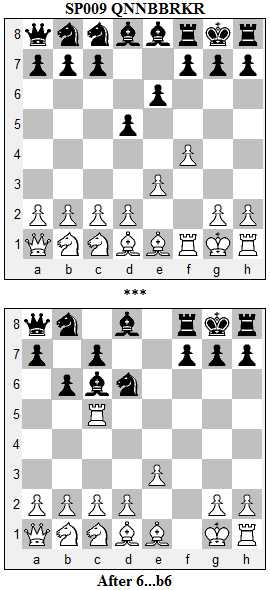I was playing White in a game on LSS that started as SP009 QNNBBRKR. One of the problems both players have is how to castle. I took a leaf from some ideas documented in a previous post -- Extreme Barbecues -- and decided I would lift the f-Rook up the f-file, thereby getting it out of the way in order to castle O-O. That explains my first moves, 1.f4 d5 2.e3 e6, reaching the position shown in the top diagram. Black has played a couple of normal developing moves.

Now I became attached to an idea that I couldn't get out of my head. It started with 3.f5. In my notes, I gave it '!?' and commented, 'Looks interesting, but is it sound? Willing to take the risk to find out...' My opponent played the obvious moves and the game continued 3...exf5 4.Rxf5 Nd6 5.Rxd5 Bc6 6.Rc5 b6, reaching the bottom diagram where the Rook is effectively trapped. Now I sacrificed the exchange with 7.Rxc6 Nxc6 8.O-O.
It looks like White is simply down the exchange with a single Pawn as compensation. According to IM (now a GM) Larry Kaufman's database research, this is more accurately calculated to be a 0.75 advantage for Black. As compensation, White has the Bishop pair (a 0.50 advantage for White) and two unopposed center Pawns (a 0.20 advantage for White). Since -0.75 + 0.50 + 0.20 gives Black a trivial advantage of -0.05, the material is almost equal. On top of this, both sides are approximately equal in development, with Black perhaps having a slight edge.
The game lasted until move 49, during which time the material imbalance transformed to a Bishop for White versus three Pawns for Black (plus other matched pieces for both sides). Although the result was a draw, the shifting dynamic imbalances were both fun to play and instructive.

No comments:
Post a Comment